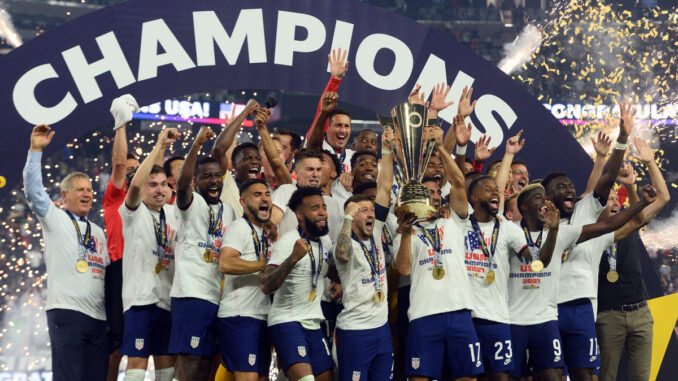
Some thought it would be hot girl summer. Some thought it would be party boy summer. But it turns out it was neither. No, in the end, it was a Stars-and-Stripes summer. Specifically, when it comes to the soccer pitch, the US Men’s National Team just beat their Mexican rivals for the second time in the span of two months on route to the Gold Cup trophy. The victory announced the arrival of a new-look men’s team and was a declaration of malicious intent. This isn’t a team of overachieving no-names. The US soccer program is now filled with young burgeoning talent that calls some of soccer’s most hallowed grounds their home. As the World Cup qualifiers approach, it’s time to introduce the American public to their future stars.
In June, the United States completed a 3-2 extra-time Nations league victory in an absolute slobber knocker of a game against their oldest rival. The voraciousness of the dominantly pro-Mexico crowd made for a tense atmosphere, as a young US team was subject to both verbal and physical projectiles. It was really the first time a full-strength men’s roster was stacked against the best of Mexico in a hostile environment. The results, especially early on, didn’t inspire confidence. A gaff in the defensive third led to an easy Mexico opener in the second minute, and a deep disparity in dominance on the ball left the team on the backfoot. But even still, Coach Gregg Berhalter’s squad showed perseverance as the Stars and Stripes pulled level off of a free kick that Borussia Dortmund starlet Gio Reyna punched in. It looked like things had finally leveled out, as the possession numbers seemed to tilt back into the US’ favor until disaster struck. Goalkeeper Zack Steffen had to be pulled in the 69th minute due to injury, and Mexico took advantage quickly. Diego Llanez dribbled into the teeth of the American defense. He buried a go-ahead goal in the 79th minute, which looked to spell doom for the team as Mexico regained control and started peppering backup keeper Ethan Horvath with shot after shot. But after an early score, Horvath held enough to allow the US to even up the score off of a corner just a couple of minutes later. The game remained tied until extra time, where some awful officiating seemed to gift the game to Mexico with a questionable penalty call. Except Horvath decided to make himself an American legend and deflected the pen back out of play. His effort allowed Christian Pulisic to bury a penalty himself just a few minutes later, winning the United States their first trophy in the Gregg Berhalter era.
It wasn’t a dominant display by any means, but a US win against a full-strength Mexico should be lauded. Some, though, weren’t so keen to give them credit. Segments of fans and media members pointed to deficiencies in the US system and said the win was more based on luck than actual unit cohesion. In response, Berhalter decided to win yet another damn trophy, only this time with a much more weakened unit.
After their nations league win, Berhalter gave a lot of obvious first teamers the rest of the summer off to rest after a long club season and grueling final. Many fringe first-teamers like Luca Del Torre and Matt Miazga were left off the roster due to unstable club situations. Instead, Berhalter went far into the deep end of the player pool to fill his Gold Cup roster. First National Team caps were handed out to Gianluca Busio, Eryk Williamson, George Bello, and James Sands – young MLSers who have started dozens of games for their squads but had yet to receive a true chance on the National stage. Matthew Hoppe of Schalke was another first-timer who flashed for a moribund Bundesliga squad that spiraled into relegation this term. Other inexperienced team members included the behemoth striker Daryl Dike, center-back Miles Robinson, and Cristian Roldan.
While critics seemed to lambast Berhalter’s choices, specifically the dearth of outright wingers on this roster, the US once again persevered. This squad cut their teeth on defense, as Robinson, Sands, Nashville FC’s Walker Zimmerman, and Colorado Rapids’ Kellyn Acosta made the middle of the pitch unplayable for opposing teams. A mix of Colorado’s Sam Vines, Tenerife’s Shaq Moore, Boavista’s Reggie Cannon, and Bello all used their athleticism to make opposing wingers work. And to cap it all off, New England Revolution’s Matt Turner was a standout in the net all tournament, snuffing any shot that managed to get through the US line. All this amounted to a whopping zero goals from open play, with the only goal scored against the United States being a PK that was put in during a 6-1 blowout of Martinique.
Such defensive resilience allowed for a mixed bag from the offensive side of the ball. While players like Robinson and Turner made cases as starters on the first team, no one offensively really made themselves undeniable. Young starters Williamson and Busio showed flashes, but both seemed overmatched physically on the pitch. The much-ballyhooed Dike scored some nice goals but struggled in both hold-up play and connecting with other members of his offensive unit. Colorado’s Jonathan Lewis was miserable. Even stalwarts like LA Galaxy’s Sebastian Lletgett and DC United’s Paul Arriola were subpar. Columbus Crew’s Gyasi Zardes did live up to his normal, hard-working, productive billing, though. The lone bright spot was a somewhat dazzling performance by Hoppe, who seemed to be the only person that could dribble with intent into dangerous areas. But even he showed some weaknesses playing out of position as a winger, and his finishing was off as he only produced a lone goal all tournament.
Still, it was enough as the United States could shut out a mostly-full strength Mexico in the Gold Cup final. After absorbing attack-after-attack in the first half (props to Acosta and Robinson shutting down many of those single-handedly), the United States clawed themselves into the game in the second half and overtime. After some frustrating misses, the US finally punched in a goal in the 117th minute by who else but Miles freakin’ Robinson, who made himself an American hero with one beautiful knock on the ball with his giant head. Champions, once again, the United States showed it could not only win with its young stars but also with its depth.
Which bodes so well for the upcoming US qualifiers. The qualifying cycle is long, tough, and grueling. Even more so in 2021, as federations are forced to make up for lost time due to the pandemic, meaning that the US will be forced to play three games per window instead of two. They will also be taking place during some of the heaviest schedules of the club season, as teams like Chelsea, Dortmund, and Juventus will be playing in the Champions League as well as playing week-to-week. This means star players like Christian Pulisic, Gio Reyna, Weston Mckinnie, and Tyler Adams will be stretched pretty thin – with all those players (minus Reyna) having to miss time in the past with soft tissue injuries. That makes the emergence of players like Acosta, Hoppe, and Robinson so important as it will be all hands on deck when it comes to these upcoming international windows.
As exciting as these rising US superstars are, the USMNT will need their depth to rise to the occasion to ensure they will qualify for Qatar in 2022. All signs indicate that they are ready for the task.



